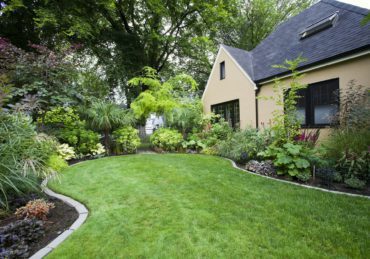Fallen leaves can be both a nuisance and a natural benefit for your lawn, depending on how you manage them. While a thick layer of leaves may suffocate grass and invite pests, mulched leaves can enrich the soil and promote healthy growth. Proper leaf care is crucial for maintaining a lush, thriving lawn. Dive into expert tips to decide whether to mulch or rake leaves, and ensure your yard thrives this fall.
Do Leaves Kill Grass? Causes and Solutions
Fallen leaves can greatly harm grass by blocking sunlight and air circulation, which are crucial for photosynthesis and respiration. This accumulation can create a conducive environment for fungal diseases, ultimately threatening the health of your lawn. Understanding the importance of proper leaf management is essential for maintaining a thriving and resilient turf.
How Leaves Can Harm Grass
Excessive leaf buildup, especially when wet, can wreak havoc on your lawn by smothering the grass. A dense layer of leaves blocks sunlight, which is essential for photosynthesis, depriving your grass of the energy it needs to grow. Trapped moisture underneath the leaves creates a damp, oxygen-poor environment that limits airflow to the soil and encourages fungal growth, such as mold and mildew. These conditions weaken the grass and can lead to discoloration, thinning, or complete die-off in severe cases. Additionally, prolonged moisture can attract pests and contribute to soil compaction, further hindering grass health. Wet leaves are particularly problematic, as they form a heavy, matted layer that’s harder to remove and accelerates these issues. Regular raking, mulching, or other leaf management strategies are essential to prevent such damage and ensure your lawn remains healthy throughout the fall season.
Why Proper Leaf Management Matters
Managing leaves effectively is essential for maintaining a healthy lawn and supporting soil health. When leaves pile up and are left untouched, they can block sunlight, trap excess moisture, and create an environment conducive to mold and pests, potentially suffocating your grass. Raking removes this barrier, giving your lawn the sunlight and airflow it needs to thrive. Alternatively, mulching leaves with a mower breaks them into small pieces that decompose quickly, adding organic mater and nutrients like nitrogen to the soil. This method not only prevents grass damage but also enhances soil fertility. Composting is another eco-friendly approach; collected leaves can break down into rich, nutrient-dense compost, perfect for future lawn or garden use. By choosing the right leaf management strategy, you can prevent harm to your grass while boosting the soil’s natural health.
Do Fallen Leaves Kill Grass Over Winter?
Fallen leaves can pose significant threats to grass health during the winter months, particularly when compounded by snow and moisture. Thick layers of leaves may smother turfgrass, leading to reduced sunlight exposure and increased risks of fungal diseases like snow mold. Implementing effective preventative lawn care measures is essential for safeguarding your lawn’s health as winter approaches.
The Effect of Snow and Wet Leaves on Grass
Leaves left on grass during winter can freeze under snow, creating harmful layers that suffocate the grass beneath. When snow falls on an unraked lawn, the trapped leaves form a dense, frozen barrier that blocks sunlight and airflow, depriving grass of essential nutrients. This layer hold moisture, creating ideal conditions for fungal diseases like snow mold to develop. Over time, the suffocating effect and constant exposure to moisture weakens the grass, often leading to winter kill, a condition where grass dies off during the colder months and struggles to regrow in spring. The combined weight of leaves and snow can also compact the soil, further hindering recovery. Clearing leaves before winter or mulching them ensures proper lawn aeration, helping grass survive harsh weather and emerge healthy in spring.
Preventative Lawn Care for Winter Health
Clearing leaves before winter is essential to protect your lawn, and timing is key to preventing damage. Start raking when leaves begin accumulating, and aim to clear them before the first heavy frost or snowfall. Use a sturdy rake or a leaf blower to remove thick layers of leaves, especially in high-traffic areas. For an eco-friendly option, mulch the leaves with a lawn mower equipped with a mulching blade. This breaks them into small pieces that can decompose, enriching your soil. Be careful not to mulch overly wet leaves, as they can clump and smother the grass. Clear leaves consistently throughout the fall to avoid overwhelming your lawn and ensure it remains well-aerated, healthy, and ready to withstand winter conditions.
What Happens If You Leave Leaves on Grass?
Leaving leaves on grass can have significant consequences, both positive and negative. While a thin layer may contribute to soil health through decomposition, excessive accumulation can smother the grass and promote fungal diseases. Understanding the balance between managing leaf coverage and leveraging its benefits is essential for maintaining a healthy lawn.
Pros and Cons of Leaving Leaves
Leaving leaves on grass can have both benefits and drawbacks, making it important to assess your lawn’s needs before deciding. On the positive side, a light layer of leaves can act as natural mulch, gradually decomposing and returning nutrients like nitrogen and phosphorus to the soil. This recycling process enriches soil health and reduces the need for synthetic fertilizers. Leaves also provide insulation, protecting grass roots from temperature fluctuations. However, the drawbacks arise when to many leaves accumulate. A thick, unbroken layer can smother grass, blocking sunlight and airflow, which are crucial for growth. This can lead to moisture buildup, promoting fungal diseases and pests, and potentially causing grass to die off. Balancing leaf cover by mulching or composting excess leaves, you can avoid potential harm to your lawn.
The Role of Leaf Decomposition in Soil Health
Mulched leaves decompose naturally, enriching soil by breaking down into organic matter that improves texture and fertility. As leaves decay, they release essential nutrients like nitrogen, phosphorus, and potassium, which promote healthy grass and plant growth. Mulching also enhances soil structure, improving aeration and water retention. Homeowners can effectively mulch leaves by using a lawn mower equipped with a mulching blade. Mow over dry leaves repeatedly until they are shredded into small pieces, ensuring they settle between the grass blades rather than forming a thick layer. Aim to keep mulched leaves thin to avoid smothering the lawn. For best results, mulch leaves regularly during the fall to prevent overwhelming the lawn.
How to Manage Leaves Without Damaging Your Lawn
Effective leaf management is essential for maintaining a healthy lawn during the fall season. Homeowners should consider whether to rake or mulch leaves, as both strategies can greatly impact grass vitality and soil health. Moreover, utilizing leaves as a natural fertilizer can enhance nutrient availability, promoting a vibrant and resilient lawn.
To Rake or Mulch: Finding the Right Strategy
Leaf removal methods like raking, bagging, and mulching with a mower each have unique benefits and drawbacks, depending on your lawn’s size and condition. Raking is a traditional approach, ideal for smaller lawns or areas with dense leaf coverage. It allows for precise removal but can be labor intensive and time consuming, especially for large yards. Begging, often combined with raking or leaf blowers, keeps the lawn tidy and prevents any leftover debris from smothering grass. However, it produces waste unless you compost the leaves. Mulching with a mower is efficient for larger lawns and doubles as a natural fertilizer by shredding leaves into find pieces that decompose into the soil. Yet, it’s less effective for wet or thick leave piles, which can clump and harm the grass. The bet method depends on your lawn’s size, leaf volume, and whether you prioritize convenience, environmental impact, or lawn health.
Using Leaves as Natural Fertilizer
Mulching and composting leaves are excellent ways to create natural fertilizer for healthier soil and grass. To mulch, start by mowing dry leaves with a lawn mower fitted with a mulching blade. Ajust the mower height to ensure the leaves are shredded into small, dime-sized pieces. Spread the mulched leaves evenly over the lawn, keeping the layer thin to avoid smothering grass. These pieces decompose quickly, enriching the soil with nutrients like nitrogen and potassium. For composting, gather leaves into a pile or compost bin. Mix them with green materials, such as grass clippings or kitchen scraps, in a 2:1 ratio of brown (leaves) to green. Turn the pile weekly to aerate it and speed decomposition. Maintain moderate moisture, damp but not soaked. Within a few months, the leaves will break down into rich compost, ready to use as a natural fertilizer for your lawn or garden beds.
Will Leaves Kill Grass? Final Thoughts
Proactive leaf management is essential to protect your lawn during fall and winter. Whether through raking, mulching, or composting, removing or properly breaking down leaves prevents grass from suffocating and reduces the risk of fungal growth and winter damage. By keeping your lawn clear and aerated, you ensure it receives the sunlight and nutrients needed to thrive. With consistent care, you can prevent grass damage, enrich your soil naturally, and promote a lush, healthy lawn year-round.




